ACUFO-1945-03-24-NAGOYA-1
The Tactical Mission Report No. 45, of the Headquarters XXIst Bomber Command of the U.S. Army Air Forces, documents the bomb raid on the Mitsubishi Aircraft Engine Works of Nagoya, Japan, on March 24, 1945.
In the “Air-to-air bombing and rockets” part of the report, it indicated that “no air-to-air bombing was reported”.
But it also reported that “a yellow ball of fire about 6 inches in diameter was observed over Nagoya moving upward at approximately 75°”; it burned out at 8000 feet.
Also, “Orange and red flashed were seen over Nagoya, possibly inaccurate rockets”, and “Six white balls of fire were seen to come up from Nagoya”; “Ground air-to-air rockets were reported as follows by the crews of the 313th Wing”, 1 at Okada and 1 at Toyohashi. These rose to 8000 feet, before burning out, and they had a red flame.
Two to six rockets or balls of fire were reported over Nagoya near Nagoya Castle, 3-4 in the southeastern part of the town, and 3 near the target.
Also, crews of the 314th Wing reported “Five possible rockets over Nagoya and 1 near Hamamatsu.” Aircraft 44-69776 reported rockets fired in bursts of 3 directly above Hori Canal. Aircraft 44-24833 reported 3 volleys of rockets over the target. Each volley contained 5 rockets which rose to 9000 ft. and burst. Aircraft 44-69677 sighted over Nagoya 2 or 3 possible rockets “which resembled gas explosions.” The bursts were reddish-orange and far brighter than anti-aircraft fire.
Aircraft 44-69696 observed a greyish ball of fire about the size of a soccer ball passing the aircraft in the target area.
Shortly after leaving the target area, 1 crew sighted phosphorus bombs or rockets bursting at 7000 ft. directly behind the aircraft, leaving a huge white puff with steamers. This projectile was believed fired from the ground.
Finally, near land's end, a red ball of fire was seen coming up from below one crew.
Next, an article titled “Balls of Fire” was published in the Air Intelligence Report secret bulletin of XXIst Bomber Command, in Volume 1, No 8, for April 26, 1945.
This article, after a presentation of the “Baka” aka “Viper” piloted rocket suicide bomb (see my Discussion section), a chapter title “Are these fireballs?” expanded on whether this craft was the “balls of fire” reported by B-29 pilots in the Pacific in 1944 - 1945. 12 examples of reports of “balls of fire” were cited; unfortunately, generally without date or location or information on the involved unit.
The first example cited was:
1.
“A yellow ball of fire about six inches in diameter observed moving upwards at an angle of about 75 degrees. Fire burned out at 8,000 feet. Six white balls of fire seen to come up from Nagoya. A greyish ball of fire about the size of a soccer ball passing below the aircraft in the target area. A red ball of fire was seen coming up from below.”
The report commented that “Some of these reports such as (1) appear to refer to ground launched rockets”; while others “have the characteristics of rocket projectiles launched from enemy aircraft.” The comment told about some of the other reports as unexplained and weird, remaining an “unsolved mystery”; but it can be seen that example 1 seemed to be about ground launched rockets.
Though, ufology sources on the Web indicated that in the 2007 book “Strange Company - Military Encounters with UFOs in World War II” by Keith Chester, a case of March 24, 1945, in the evening in Nagoya, Japan, during the XXIst Bomber Command B-29s raid to destroy the Mitsubishi Aircraft Engine works in Nagoya, B-29 crews observed a variety of pyrotechnic activity: “a yellow ball of fire about six inches in diameter”; “orange and red flashes”; “six white balls of fire”; apparent rocket bursts resembling gas explosions, appearing reddish-orange in color, “far brighter than anti-aircraft fire”; “a grayish ball of fire about the size of a soccer ball”; and a “red ball of fire” coming up from below.”
| Date: | March 24, 1945 |
|---|---|
| Time: | Night. |
| Duration: | ? |
| First known report date: | March 1945 |
| Reporting delay: | Days. |
| Country: | Japan |
|---|---|
| State/Department: | Aichi |
| City or place: | Nagoya |
| Number of alleged witnesses: | Several. |
|---|---|
| Number of known witnesses: | Several. |
| Number of named witnesses: | 0 |
| Reporting channel: | ? |
|---|---|
| Visibility conditions: | Night. |
| UFO observed: | Yes. |
| UFO arrival observed: | Yes. |
| UFO departure observed: | Yes. |
| UFO action: | Come from the ground, explode, fall. |
| Witnesses action: | |
| Photographs: | No. |
| Sketch(s) by witness(es): | No. |
| Sketch(es) approved by witness(es): | No. |
| Witness(es) feelings: | ? |
| Witnesses interpretation: | ? |
| Sensors: |
[X] Visual: Several.
[ ] Airborne radar: [ ] Directional ground radar: [ ] Height finder ground radar: [ ] Photo: [ ] Film/video: [ ] EM Effects: [ ] Failures: [ ] Damages: |
|---|---|
| Hynek: | NL |
| Armed / unarmed: | Armed, 12 Browning M2 12,7 mm machine guns. |
| Reliability 1-3: | 3 |
| Strangeness 1-3: | 1 |
| ACUFO: | Probable ground-to-air rockets and air-to-air fire bombs. |
[Ref. aaf1:] U.S. ARMY AIR FORCES:
Header of this report:
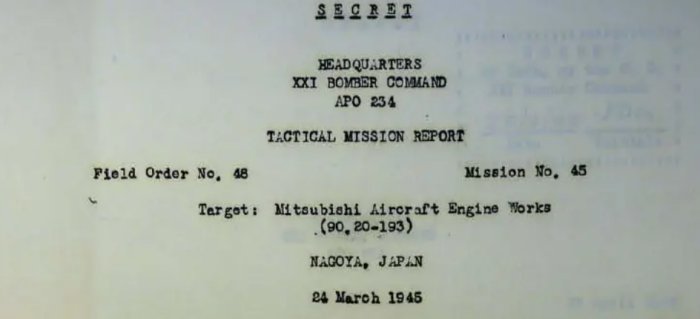
|
S E C R E T
HEADQUARTERS
XXI BOMBER COMMAND
APO 234
TACTICAL MISSION REPORT
Field Order No. 48
Mission No. 45
Target: Mitsubishi Aircraft Engine Works
(90, 20-193)
NAGOYA, JAPAN
24 March 1945
Mission route and schedule:
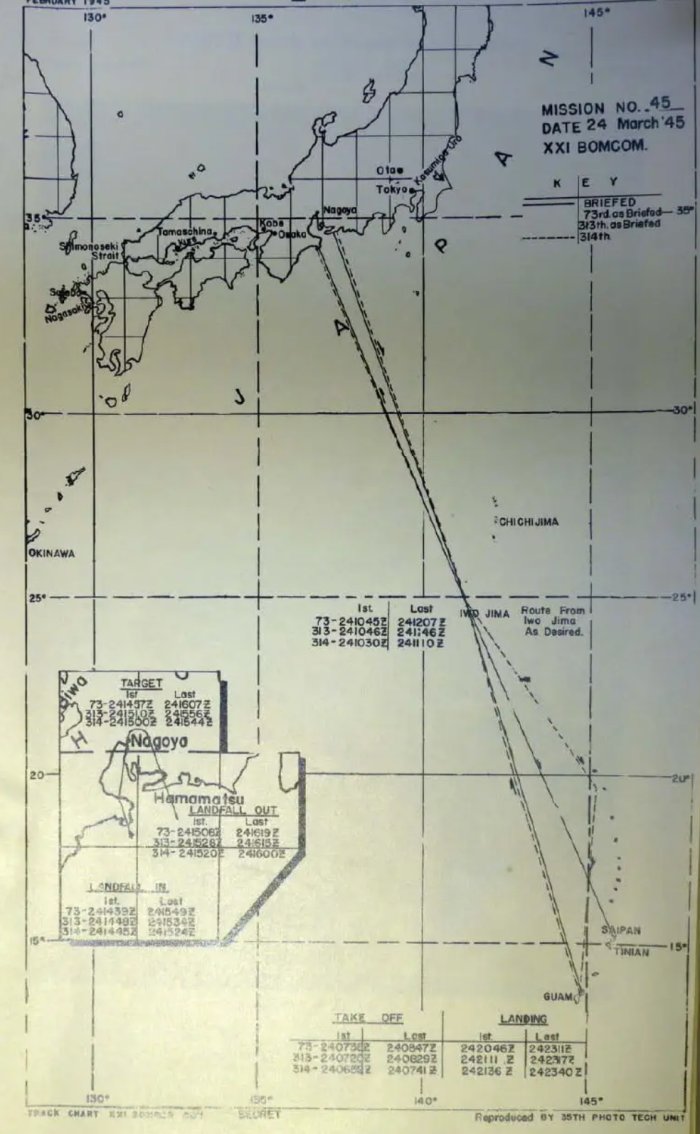
|
TAKE OFF
1st
73 - 240738Z
313 - 240720Z
314 - 2400632Z
Last
73 - 240848Z
313 - 240829Z
314 - 240741Z
LANDING
1st
73 - 242046Z
313 - 242111Z
314 - 242136Z
Last
73 - 242311Z
313 - 242317Z
314 - 242340Z
Weather over target:

|
[Forecast:] Target: 4/10 stratocumulus, base 3000 ft, top 6000 ft, visibility 6-9 miles. Wind at 7000 ft: 310°34 knots.
[Actual weather:] 4/10 stratocumulus, base 3000 ft, top 7-8000 ft; visibility 15 miles being lowered to 2 miles in smoke. Winds at 7000 fr; 310° at 36 knots.
The report documents heavy and medium flak, moderate sometimes inaccurate but mostly accurate; dozens of searchlights including some with blue beams; about five barrage balloons, and 1 red flare.
The report documents more than a 100 enemy planes spotted, of all kinds, very few were identified (2 Tonys, 1 Zeke, 1 Irving, 1 Nick, 2 possibly Bettys.) Of the unidentified, there were 1 twin-engined transport, 1 twin-engined twin-tailed, 12 unidentified twin-engined, 4 single-engined, and 68 entirely unidentified. Most of the enemy plane did not attack. Four B-29 were mildly damaged and one B-29 was possibly lost to enemy plane attacks.
In the mission report, the “phenomena” noted in the ufology sources do not appear in the “enemy opposition” part of the report - unlike in most other reports - not in the anti-aircraft section, but in the “Air-to-air bombing and rockets” part:
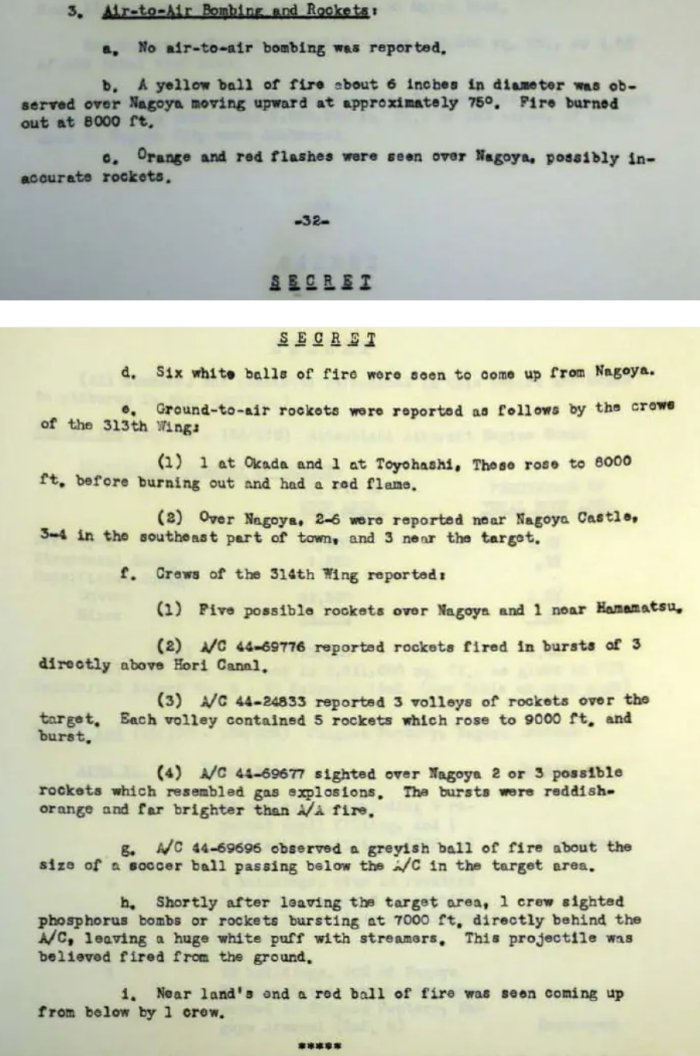
|
3. Air-to-Air Bombing and Rockets:
a. No air-to-air bombing was reported.
b. A yellow ball of fire about 6 inches in diameter was observed over Nagoya moving upward at approximately 75°. Fire burned out at 8000 ft.
c. Orange and red flashed were seen over Nagoya, possibly inaccurate rockets.
d. Six white balls of fire were seen to come up from Nagoya.
e. Ground air-to-air rockets were reported as follows by the crews of the 313th Wing:
(1) 1 at Okada and 1 at Toyohashi. These rose to 8000 feet, before burning out and had a red flame.
(2) Over Nagoya, 2-6 were reported near Nagoya Castle, 3-4 in the southeastern part of the town, and 3 near the target.
f. Crews of the 314th Wing reported:
(1) Five possible rockets over Nagoya and 1 near Hamamatsu.
(2) A/C [aircraft] 44-69776 reported rockets fired in bursts of 3 directly above Hori Canal.
(3) A/C 44-24833 reported 3 volleys of rockets over the target. Each volley contained 5 rockets which rose to 9000 ft. and burst.
(4) A/C 44-69677 sighted over Nagoya 2 or 3 possible rockets which resembled gas explosions. The bursts were reddish-orange and far brighter than A/A fire.
g. A/C 44-69696 observed a greyish ball of fire about the size of a soccer ball passing the A/C in the target area.
h. Shortly after leaving the target area, 1 crew sighted phosphorus bombs or rockets bursting at 7000 ft. directly behind the A/C, leaving a hige white puff with steamers. This projectile was believed fired from the ground.
Near land's end a red ball of fire was seen coming up from below 1 crew.
[Ref. aaf2:] U.S. ARMY AIR FORCES:
After a presentation of the “Baka” aka “Viper” piloted rocket suicide bomb (see my Discussion section), a chapter title “Are these fireballs?” expanded on whether this craft was the “balls of fire” reported by B-29 pilots in the Pacific in 1944 - 1945.
12 examples of reports of “balls of fire” are cited; unfortunately, generally without date or location or information on the involved unit.
The introduction read:
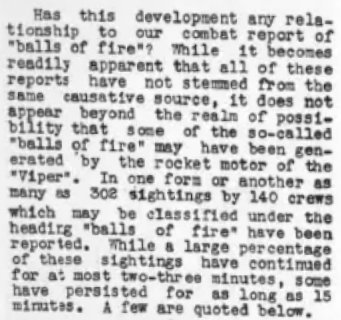
|
Has this development [the “Baka” aka “Viper”] any relationship to our combat reports of “balls of fire”? While it becomes readily apparent that all of these reports have not stemmed from the same causative source, it does not appear beyond the realm of possibility that some of the so-called “balls of fire” may have been generated by the rocket engine of the “Viper”. In one form or another as many as 302 sightings by 140 crews which may be classified under the heading of “balls of fire” have been reported. While a large percentage of these sightings have continued for at most two-three minutes, some have persisted for as long as 15 minutes. A few are quoted below.
Quoted below were indeed 12 reports summaries, including:
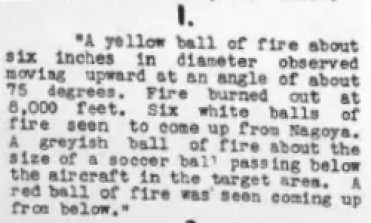
|
“A yellow ball of fire about six inches in diameter observed moving upwards at an angle of about 75 degrees. Fire burned out at 8,000 feet. Six white balls of fire seen to come up from Nagoya. A greyish ball of fire about the size of a soccer ball passing below the aircraft in the target area. A red ball of fire was seen coming up from below.”
The reports were followed by these comments:
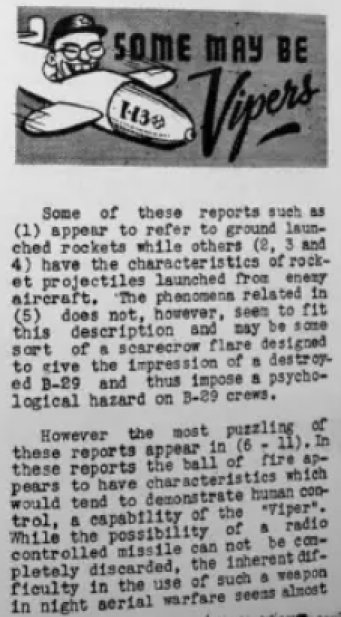
|
Some of these reports such as (1) appear to refer to ground launched rockets while others (2, 3 and 4) have the characteristics of rocket projectiles launched from enemy aircraft. The phenomena related in (5) does not, however, seem to fit this description and may be some sort of a scarecrow flare designed to give the impression of a destroyed B-29 and thus impose a psychological hazard on B-29 crews.
However the most puzzling of these reports appear in (6 - 11). In these reports the ball of fire appears to have characteristics which would tend to demonstrate human control, a capacity of the “Viper”. While the possibility of a radio controlled missile cannot be completely discarded, the inherent difficulty in the use of such a weapon in night aerial warfare seems almost
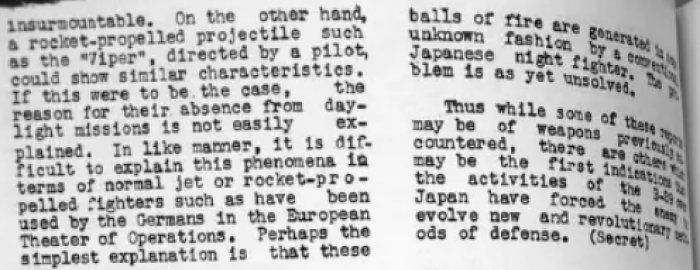
|
insurmountable. On the other hand, a rocket-propelled projectile such as the “Viper”, directed by a pilot, could show similar characteristics.
If this were to be the case, the reason for their absence from daytime missions is not easily explained. In like manner, it is difficult to explain these phenomena in terms of normal jet or rocket-propelled fighters such as have been used by the Germans in the European Theater of Operations. Perhaps the simplest explanation is that these balls of fire are generated in an unknown fashion by a conventional Japanese night fighter. The problem is as yet unsolved.
Thus while some of these reports may be of weapons previously encountered, there are others which may be the first indications that the activities of the B-29 have forced the enemy to evolve new and revolutionary methods of defense. (Secret)
[Ref. dwn2:] DOMINIQUE WEINSTEIN:
At evening, the XXI Bomber Command began with operations against mainland Japan, sending their B-29s on a raid to destroy the Mitsubishi Aircraft Engine works in Nagoya. B-29 crews observed a variety of pyrotechnic activity: “a yellow ball of fire about six inches in diameter”; “orange and red flashes”; “six white balls of fire”; apparent rocket bursts resembling gas explosions, appearing reddish-orange in color, “far brighter than anti-aircraft fire”; “a grayish ball of fire about the size of a soccer ball”; and a “red ball of fire” coming up from below.”
Sources: Headquarters XXI Bomber Command, Tactical Mission Report, Report n°45, NARA / Strange Company, Keith Chester, 2007
(Ref. nip1:) "THE NICAP WEBSITE":
March 24, 1945; Nagoya, Japan
Multiple sightings: yellow ball of fire about 6 inches in diameter; orange and red flashes; six white balls of fire; grayish ball of fire about size of soccer ball; red ball of fire. (Page 152-153 Ref.1)
The reference 1 is described at the end of the document as “Strange Company (2007), Keith Chester”.
[Ref. tai1:] "THINK ABOUT IT" WEBSITE:
Date: Mar. 24, 1945
Location: Nagoya, Japan
Time:
Summary: Multiple sightings: yellow ball of fire about 6 inches in diameter; orange and red flashes; six white balls of fire; grayish ball of fire about size of soccer ball; red ball of fire.
Source:
The Boeing B-29 “Superfortress” was the heaviest bomber of the U.S. Army Air Forces, used in operations from May 8, 1944 and on. Its maximum speed was 574 km/h.
Its defensive armament was 12 Browning M2 12.7 mm machine guns.
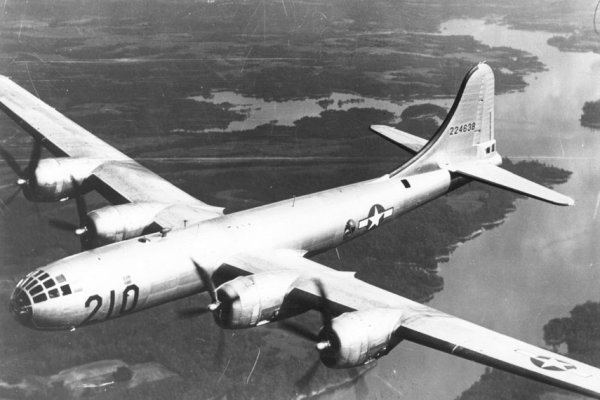
|

|
This is one of the XXIst Bomber Command Tactical Mission reports in which it is quite impossible to determine whether any of the reported phenomena were anything else than the usual anti-aircraft “pyrotechnics” used by the Japanese:
Nothing is entirely certain with such explanations. For example, the report specified that “no air-to-air bombing was reported”. Yet, we are also told: “1 crew sighted phosphorus bombs or rockets bursting at 7000 ft. directly behind the A/C.”
It not meaningless that the phenomena cited in the UFO literature were in fact in the “air-to-air bombings and rockets” section of the mission report.
It appears that none of the reported lights and fires did anything that Japanese anti-aircraft weapons could not have performed.
Probable ground-to-air rockets and air-to-air fire bombs.
* = Source is available to me.
? = Source I am told about but could not get so far. Help needed.
| Main author: | Patrick Gross |
|---|---|
| Contributors: | None |
| Reviewers: | None |
| Editor: | Patrick Gross |
| Version: | Create/changed by: | Date: | Description: |
|---|---|---|---|
| 0.1 | Patrick Gross | May 2, 2024 | Creation, [aaf1], [aaf2], [dwn2], [nip1], [tai1]. |
| 1.0 | Patrick Gross | May 2, 2024 | First published. |